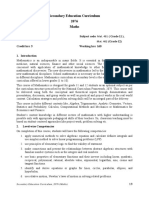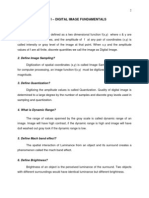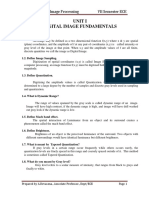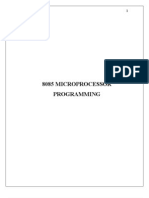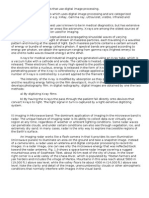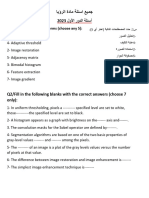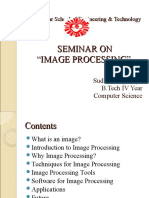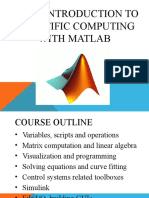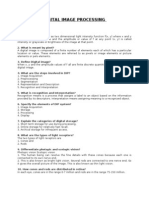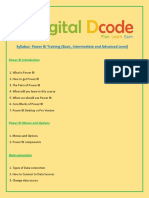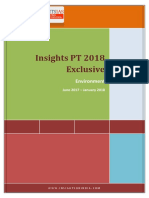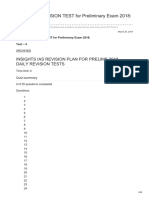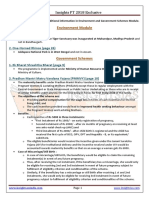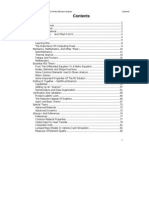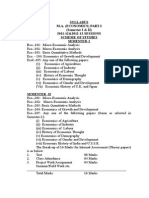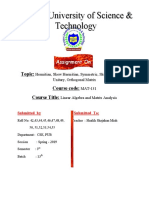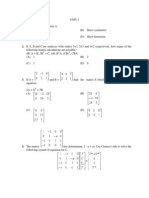Digital Image Processing - 2 Marks-Questions and Answers
Digital Image Processing - 2 Marks-Questions and Answers
Uploaded by
nikitatayaCopyright:
Available Formats
Digital Image Processing - 2 Marks-Questions and Answers
Digital Image Processing - 2 Marks-Questions and Answers
Uploaded by
nikitatayaOriginal Description:
Original Title
Copyright
Available Formats
Share this document
Did you find this document useful?
Is this content inappropriate?
Copyright:
Available Formats
Digital Image Processing - 2 Marks-Questions and Answers
Digital Image Processing - 2 Marks-Questions and Answers
Uploaded by
nikitatayaCopyright:
Available Formats
Wednesday, 24 October 2012
Digital Image processing -2 Marks-Questions and Answers
UNIT I DIGITAL IMAGE FUNDAMENTALS AND TRANSFORMS
1. Define Image? An Image may be defined as a two dimensional function f (x,y) where x & y are spatial (plane) coordinates, and the amplitude of f at any pair of coordinates (x,y) is called intensity or gray level of the image at that point. When x,y and the amplitude values of f are all finite, discrete quantities we call the image as Digital Image. 2. Define Image Sampling? Digitization of spatial coordinates (x,y) is called Image Sampling. To be suitable for computer processing, an image function f(x,y) must be digitized both spatially and in magnitude. 3. Define Quantization ? Digitizing the amplitude values is called Quantization. Quality of digital image is determined to a large degree by the number of samples and discrete gray levels used in sampling and quantization. 4. What is Dynamic Range? The range of values spanned by the gray scale is called dynamic range of an image. Image will have high contrast, if the dynamic range is high and image will have dull washed out gray look if the dynamic range is low. 5. Define Mach band effect? The spatial interaction of Luminance from an object and its surround creates a Phenomenon called the mach band effect. 6. Define Brightness? Brightness of an object is the perceived luminance of the surround. Two objects with different surroundings would have identical luminance but different brightness. 7. Define Tapered Quantization? If gray levels in a certain range occur frequently while others occurs rarely, the quantization levels are finely spaced in this range and coarsely spaced outside of it.This method is sometimes called Tapered Quantization. 8. What do you meant by Gray level? Gray level refers to a scalar measure of intensity that ranges from black to grays and finally to white.
9. Define Resolutions? Resolution is defined as the smallest number of discernible detail in an image. Spatial resolution is the smallest discernible detail in an image and gray level resolution refers to the smallest discernible change is gray level.
10. Write the M X N digital image in compact matrix form? f(x,y )= f(0,0) f(0,1)f(0,N-1) f(1,0) f(1,1)f(1,N-1) . . . f(M-1) f(M-1,1)f(M-1,N-1) 11. Write the expression to find the number of bits to store a digital image? The number of bits required to store a digital image is b=M X N X k When M=N, this equation becomes b=N^2k 12. What do you meant by Zooming of digital images? Zooming may be viewed as over sampling. It involves the creation of new pixel locations and the assignment of gray levels to those new locations. 13. What do you meant by shrinking of digital images? Shrinking may be viewed as under sampling. To shrink an image by one half, we delete every row and column. To reduce possible aliasing effect, it is a good idea to blue an image slightly before shrinking it. 14. Define the term Radiance? Radiance is the total amount of energy that flows from the light source, and it is usually measured in watts (w). 15. Define the term Luminance? Luminance measured in lumens (lm), gives a measure of the amount of energy an observer perceiver from a light source. 16. What is Image Transform? An image can be expanded in terms of a discrete set of basis arrays called basis images. Unitary matrices can generate these basis images. Alternatively, a given NXN image can be viewed as an N^2X1 vectors. An image transform provides a set of coordinates or basis vectors for vector space. 17. What are the applications of transform? 1) To reduce band width 2) To reduce redundancy 3) To extract feature. 18. Give the Conditions for perfect transform? Transpose of matrix = Inverse of a matrix. Orthoganality. 19. What are the properties of unitary transform? 1) Determinant and the Eigen values of a unitary matrix have unity magnitude 2) The entropy of a random vector is preserved under a unitary Transformation 3) Since the entropy is a measure of average information, this means information is preserved under a unitary transformation. 20. Write the expression of one-dimensional discrete Fourier transforms? Forward transform The sequence of x(n) is given by x(n) = { x0,x1,x2, xN-1}. X(k) = (n=0 to N-1) _ x(n) exp(-j 2* pi* nk/N) ; k= 0,1,2,N-1
Reverse transforms X(n) = (1/N) (k=0 to N-1) _ x(k) exp(-j 2* pi* nk/N) ; n= 0,1,2,N-1 21. Properties of twiddle factor? 1. Periodicity WN^(K+N)= WN^K 2. Symmetry WN^(K+N/2)= -WN^K 22. Give the Properties of one-dimensional DFT 1. The DFT and unitary DFT matrices are symmetric. 2. The extensions of the DFT and unitary DFT of a sequence and their inverse transforms are periodic with period N. 3. The DFT or unitary DFT of a real sequence is conjugate symmetric about N/2. 23. Give the Properties of two-dimensional DFT 1. Symmetric 2. Periodic extensions 3. Sampled Fourier transform 4. Conjugate symmetry. 24. What is cosine transform? The NXN cosine transform c(k) is called the discrete cosine transform and is defined as C(k) = 1/_N , k=0, 0 _ n _ N-1 = _ (2/N) cos (pi (2n+1)/2N 1_ k _ N-1, 0_ n _ N-1 25. What is sine transform? The NXN sine transform matrix = (k,n) also called the discrete sine transform is defined as (k,n) = _(2/N+1) sin [ pi* (k+1) (n+1) / (N+1)] , 0_k, n_ N-1 26. Write the properties of cosine transform? 1) Real & orthogonal. 2) Fast transform. 3) Has excellent energy compaction for highly correlated data 27. Write the properties of sine transform? 1) Real, symmetric and orthogonal. 2) Not the imaginary part of the unitary DFT. 3) Fast transform. 28. Write the properties of Hadamard transform? 1) Hadamard transform contains any one value. 2) No multiplications are required in the transform calculations. 3) The no: of additions or subtractions required can be reduced from N^2 to Nlog2N 4) Very good energy compaction for highly correlated images. 29. Define Haar transform? The Haar functions are defined on a continuous interval Xe [0,1] and for K=0,1,. N-1.Where N=2^n. The integer k can be uniquely decomposed as K=2^P+Q-1. 30. Write the expression for Hadamard transforms Hadamard transform matrices Hn are NXN matrices where N=2^n , n=
1,2,3, is defined as Hn= Hn-1 * H1 = H1* Hn-1 = 1/ _ 2 Hn-1 Hn-1 H2 = 1 1 1 1 31. What are the properties of Haar transform. 1. Haar transform is real and orthogonal. 2. Haar transform is a very fast transform 3. Haar transform has very poor energy compaction for images 4. The basic vectors of Haar matrix sequency ordered. 32. What are the Properties of Slant transform? 1. Slant transform is real and orthogonal. 2. Slant transform is a fast transform 3. Slant transform has very good energy compaction for images 4. The basic vectors of Slant matrix are not sequency ordered. 33. Define of KL Transform? KL Transform is an optimal in the sense that it minimizes the mean square error between the vectors X and their approximations X^. Due to this idea of using the Eigenvectors corresponding to largest Eigen values. It is also known as principal component transform. 34. Justify that KLT is an optimal transform. Since mean square error of reconstructed image and original image is minimum and the mean value of transformed image is zero so that uncorrelated. 35.Explain the term digital image. The digital image is an array of real or complex numbers that is represented by a finite no of bits. 36.Write any four applications of DIP. (i). Remote sensing (ii). Image transmission and storage for business application (iii). Medical imaging (iv). Astronomy 37.What is the effect of Mach band pattern. The intensity or the brightness pattern perceive a darker stribe in region D and brighter stribe in region B.This effect is called Mach band pattern or effect. 38.Write down the properties of 2D fourier transform. Separability Translation Periodicity and Conjugate property Rotation Distributivity and scaling Average value Convolution and Correlation Laplacian
39.Obtain the Hadamard transformation for N = 4
N = 4 = 2n => n = 2 40.Write down the properties of Haar transform. Real and orthogonal Very fast transform Basis vectors are sequentially ordered Has fair energy compaction for image Useful in feature extraction,image coding and image analysis problem
UNIT II IMAGE ENHANCEMENT TECHNIQUES 1. What is Image Enhancement? Image enhancement is to process an image so that the output is more suitable for specific application. 2. Name the categories of Image Enhancement and explain? The categories of Image Enhancement are 1. Spatial domain 2. Frequency domain Spatial domain: It refers to the image plane, itself and it is based on direct manipulation of pixels of an image. Frequency domain techniques are based on modifying the Fourier transform of an image. 3. What do you mean by Point processing? Image enhancement at any Point in an image depends only on the gray level at that point is often referred to as Point processing. 4. Explain Mask or Kernels? A Mask is a small two-dimensional array, in which the value of the mask coefficient determines the nature of the process, such as image sharpening. 5. What is Image Negatives? The negative of an image with gray levels in the range [0, L-1] is obtained by using the negative transformation, which is given by the expression. s = L-1-r Where s is output pixel. r is input pixel. 6.Define Histogram? The histogram of a digital image with gray levels in the range [0, L-1] is a discrete function h (rk) = nk, where rk is the kth gray level and nk is the number of pixels in the image having gray level rk. 7. Define Derivative filter? For a function f (x, y), the gradient f at co-ordinate (x, y) is defined as the
vector_f = _f/_x _f/_y _f = mag (_f) = {[(_f/_x) 2 +(_f/_y) 2 ]} 8. Explain spatial filtering? Spatial filtering is the process of moving the filter mask from point to point in an image. For linear spatial filter, the response is given by a sum of products of the filter coefficients, and the corresponding image pixels in the area spanned by the filter mask. 9. Define averaging filters? The output of a smoothing, linear spatial filter is the average of the pixels contain in the neighborhood of the filter mask. These filters are called averaging filters. 10. What is a Median filter? The median filter replaces the value of a pixel by the median of the gray levels in the neighborhood of that pixel. 11. What is maximum filter and minimum filter? The 100th percentile is maximum filter is used in finding brightest points in an image. The 0th percentile filter is minimum filter used for finding darkest points in an image. 12. Define high boost filter? High boost filtered image is defined as HBF= A (original image)-LPF = (A-1) original image + original image LPF HBF= (A-1) original image +HPF 13. State the condition of transformation function s=T(r) 1. T(r) is single-valued and monotonically increasing in the interval 0_r_1 0_T(r) _1 for 0_r_1. 14. Write the application of sharpening filters? 1. Electronic printing and medical imaging to industrial application 2. Autonomous target detection in smart weapons. 15. Name the different types of derivative filters? 1. Perwitt operators 2. Roberts cross gradient operators 3. Sobel operators 16. What is enhancement. Image enhancement is a technique to process an image so that the result is more suitable than the original image for specific applications; 17. What is point processing. Enhancement at any point in an image depends only on the gray level at that point is referred to as point processing. 18. What is gray level slicing. Highlighting a specific range of gray levels in an image is referred to as gray level slicing. It is used in satellite imagery and x-ray images. 19. What is histogram equalization?
It is a technique used to obtain linear histogram . It is also known as histogram linearization. Condition for uniform histogram is Ps(s) = 1. 20. What is contrast stretching? Contrast stretching reduces an image of higher contrast than the original by darkening the levels below m and brightening the levels above m in the image. 21. Define image subtraction. The difference between 2 images f(x,y) and h(x,y) expressed as, G(x,y)=f(x,y)-h(x,y) is obtained by computing the difference between all pairs of corresponding pixels from f and h. 22. What is the purpose of image averaging? An important application of image averaging is in the field of astronomy, where imaging with very low light levels is routine, causing sensor noise frequently to render single images virtually useless for analysis. 23. What is meant by masking? Mask is the small 2D array in which the values of mask co-efficient determines the nature of process. The enhancement techniques based on this type of approach is referred to as mask processing. 24. Give the formula for log transformation S=clog(1+r) Where c- constant and r0 25. What is meant by bit plane slicing? Instead of highlighting gray level ranges, highlighting the contribution made to total image appearance by specific bits might be desired. Suppose that each pixel in an image is represented by 8 bits. Imagine that the image is composed of eight 1-bit planes, ranging from bit plane 0 for LSB to bit plane 7 for MSB.
UNIT III IMAGE RESTORATION 1. Define Restoration? Restoration is a process of reconstructing or recovering an image that has been degraded by using a priori knowledge of the degradation phenomenon. Thus restoration techniques are oriented towards modeling the degradation and applying the inverse process in order to recover the original image. 2. How a degradation process is modeled? A system operator H, which together with an additive white noise term _(x,y) a operates on an input image f(x,y) to produce a degraded image g(x,y). 3. What is homogeneity property and what is the significance of this
property? H [k1f1(x,y)] = k1H[f1(x,y)] Where H=operator K1=constant f(x,y)=input image. It says that the response to a constant multiple of any input is equal to the response to that input multiplied by the same constant.
4. Define circulant matrix? A square matrix, in which each row is a circular shift of the preceding row and the first row is a circular shift of the last row, is called circulant matrix. Example: he(o) he(M-1) he(M-2) he(1) he(1) he(0) he(M-1). he(2) . . he(M-1) he(M-2) he(M-3). he(0) 5. What is the concept behind algebraic approach to restoration? Algebraic approach is the concept of seeking an estimate of f, denoted f^, that minimizes a predefined criterion of performance where f is the image. 6. Why the image is subjected to wiener filtering? This method of filtering consider images and noise as random process and the objective is to find an estimate f^ of the uncorrupted image f such that the mean square error between them is minimized. So that image is subjected to wiener filtering to minimize the error. 7. Define spatial transformation? Spatial transformation is defined as the rearrangement of pixels on an image plane. 8. Define Gray-level interpolation? Gray-level interpolation deals with the assignment of gray levels to pixels in the spatially transformed image. 9. Give one example for the principal source of noise? The principal source of noise in digital images arise image acquisition (digitization) and/or transmission. The performance of imaging sensors is affected by a variety of factors, such as environmental conditions during image acquisition and by the quality of the sensing elements. The factors are light levels and sensor temperature. 10. When does the degradation model satisfy position invariant property? An operator having input-output relationship g(x,y)=H[f(x,y)] is said to position invariant if H[f(x-,y-_)]=g(x-,y-_) for any f(x,y) and and _. This definition indicates that the response at any point in the image depends only on the value of the input at that point not on its position. 11. Why the restoration is called as unconstrained restoration? In the absence of any knowledge about the noise n, a meaningful criterion function is to seek an f^ such that H f^ approximates of in a least square sense by assuming the noise term is as small as possible. Where H = system operator. f^ = estimated input image. g = degraded image.
12. Which is the most frequent method to overcome the difficulty to formulate the spatial relocation of pixels? The point is the most frequent method, which are subsets of pixels whose location in the input (distorted) and output (corrected) imaged is known precisely. 13. What are the three methods of estimating the degradation function? 1. Observation 2. Experimentation 3. Mathematical modeling. 14. How the blur is removed caused by uniform linear motion? An image f(x,y) undergoes planar motion in the x and y-direction and x0(t) and y0(t) are the time varying components of motion. The total exposure at any point of the recording medium (digital memory) is obtained by integrating the instantaneous exposure over the time interval during which the imaging system shutter is open. 15. What is inverse filtering? The simplest approach to restoration is direct inverse filtering, an estimate F^(u,v) of the transform of the original image simply by dividing the transform of the degraded image, G^(u,v) by the degradation function. F^ (u,v) = G^(u,v)/H(u,v) 16. Give the difference between Enhancement and Restoration? Enhancement technique is based primarily on the pleasing aspects it might present to the viewer. For example: Contrast Stretching. Where as Removal of image blur by applying a deblurrings function is considered a restoration technique. 17.Define the degradation phenomena? Image restoration or degradation is a process that attempts to reconstruct or recover an image that has been degraded by using some clear knowledge of the degradation phenomena. Degradation may be in the form of Sensor noise Blur due to camera misfocus Relative object camera motion
18.What is unconstrained restoration. It is also known as least square error approach.n = g-Hf To estimate the original image f^,noise n has to be minimized and f^ = g/H. 19.What is blind image restoration Degradation may be difficult to measure or may be time varying in an unpredictable manner. In such cases information about the degradation must be extracted from the observed image either explicitly or implicitly. This task is called blind image restoration. 20. What are the 2 properties in Linear operator? * Additivity * Homogenity 21.Explain additivity property in Linear Operator?
H[f1(x,y)+f2(x,y)]=H[f1(x,y)]+H[f2(x,y)] 22.What are the 2 methods of algebraic approach? * Unconstraint restoration approach * Constraint restoration approach 23. What is meant by Noise probability density function? The spatial noise descriptor is the statistical behavior of gray level values in the noise component of the model. 24. What are the types of noise models? Guassian noise Rayleigh noise Erlang noise
25. What is meant by least mean square filter? The limitation of inverse and pseudo inverse filter is very sensitive noise. The wiener filtering is a method of restoring images in the presence of blur as well as noise. 26. What are the 2 approaches for blind image restoration? Direct measurement Indirect estimation
UNIT IV IMAGE COMPRESSION 1. What is Data Compression? Data compression requires the identification and extraction of source redundancy. In other words, data compression seeks to reduce the number of bits used to store or transmit information. 2. What are two main types of Data compression? Lossless compression can recover the exact original data after compression. It is used mainly for compressing database records, spreadsheets or word processing files, where exact replication of the original is essential. _Lossy compression will result in a certain loss of accuracy in exchange for a substantial increase in compression. Lossy compression is more effective when used to compress graphic images and digitised voice where losses outside visual or aural perception can be tolerated. 3. What is the need for Compression? In terms of storage, the capacity of a storage device can be effectively increased with methods that compress a body of data on its way to a storage device and decompresses it when it is retrieved. In terms of communications, the bandwidth of a digital communication link can be effectively increased by compressed data at the sending end and decompressing data at the receiving end. At any given time, the ability of the Internet to transfer data is fixed. Thus, if data can effectively be compressed wherever possible, significant improvements of data throughput can be achieved. Many files can be combined into one compressed document making sending easier. 4. What are different Compression Methods? (1) Run Length Encoding (RLE) (2) Arithmetic coding (3) Huffman coding (4) Transform coding 5. What is run length coding? Run-length Encoding,( RLE) is a technique used to reduce the size of a repeating string of characters. This repeating string is called a run; typically RLE encodes a run of symbols into two bytes, a count and a symbol. RLE can compress any type of data regardless of its information content, but the content of data to be compressed affects the compression ratio. Compression is normally measured with the compression ratio: 6. Define compression ratio. Compression Ratio = original size / compressed size: 1 7. Give an example for Run length Encoding. Consider a character run of 15 A characters, which normally would require 15 bytes to store: AAAAAAAAAAAAAAA coded into 15A With RLE, this would only require two bytes to store; the count (15) is stored as the first byte and the symbol (A) as the second byte.
8. What is Huffman Coding? Huffman compression reduces the average code length used to represent the symbols of an alphabet. Symbols of the source alphabet, which occur frequently, are assigned with short length codes. The general strategy is to allow the code length to vary from character to character and to ensure that the frequently occurring characters have shorter codes. 9. What is Arithmetic Coding? Arithmetic compression is an alternative to Huffman compression; it enables characters to be represented as fractional bit lengths. Arithmetic coding works by representing a number by an interval of real numbers greater or equal to zero, but less than one. As a message becomes longer, the interval needed to represent it becomes smaller and smaller, and the number of bits needed to specify it increases. 10. What is JPEG? The acronym is expanded as "Joint Photographic Expert Group". It is an international standard in 1992. It perfectly Works with colour and greyscale images, Many applications e.g., satellite, medical, etc, 11. What are the basic steps in JPEG? The Major Steps in JPEG Coding involves DCT (Discrete Cosine Transformation) Quantization Zigzag Scan DPCM on DC component RLE on AC Components Entropy Coding 12. What is MPEG? The acronym is expanded as "Moving Picture Expert Group". It is an international standard in 1992. It perfectly Works with video and also used in teleconferencing. 13. What is transform coding? Transform coding is used to convert spatial image pixel values to transform coefficient values. Since this is a linear process and no information is lost, the number of coefficients produced is equal to the number of pixels transformed. The desired effect is that most of the energy in the image will be contained in a few large transform coefficients. If it is generally the same few coefficients that contain most of the energy in most pictures, then the coefficients may be further coded by lossless entropy coding. In addition, it is likely that the smaller coefficients can be coarsely quantized or deleted (lossy coding) without doing visible damage to the reproduced image. 14. What are the different transforms used in transform coding and how the differ? Many types of transforms used for picture coding, are Fourier, Karhonen-Loeve, Walsh - Hadamard, lapped orthogonal, discrete cosine (DCT), and recently, wavelets. The various transforms differ among themselves in three basic ways that are of interest in picture coding: 1) The degree of concentration of energy in a few coefficients; 2) The region of influence of each coefficient in the reconstructed picture; 3) The appearance and visibility of coding noise due to coarse quantization of the coefficients.
15.Find the number of bits to store a 128_128 image with 64 gray levels. Given: M = N = 128 L = 64 =2k => k=6 No. of bits = M2k = 1282*6 = 98304 bits 16. What is image compression? Image compression refers to the process of redundancy amount of data required to represent the given quantity of information for digital image. The basis of reduction process is removal of redundant data. 17. Define coding redundancy. If the gray level of an image is coded in a way that uses more code words than necessary to represent each gray level, then the resulting image is said to contain coding redundancy. 18. Define interpixel redundancy. The value of any given pixel can be predicted from the values of its neighbors. The information carried by is small. Therefore the visual contribution of a single pixel to an image is redundant. Otherwise called as spatial redundant geometric redundant or interpixel redundant. Example : Run length coding 19. What is psycho visual redundancy? In normal visual processing certain information has less importance than other information. So this information is said to be psycho visual redundant.
20. Define encoder. Source encoder is responsible for removing the coding and interpixel redundancy and psycho visual redundancy. There are 2 components a) Source Encoder b) Channel Encoder 21. Define Source encoder. Source encoder performs 3 operations 1) Mapper this transforms the input data into non-visual format. It reduces the interpixel redundancy. 2) Quantizer- It reduces the psycho visual redundancy of the input images. This step is omitted if the system is error free. 3) Symbol encoder This reduces the coding redundancy. This is the final stage of encoding process. 22. Define channel encoder The channel encoder reduces the impact of the channel noise by inserting redundant bits into the source encoded data. Example : Hamming code 23. What are the types of decoder? Source decoder has 2 components. a) Symbol decoder This performs inverse operation of symbol encoder. b) Inverse Mapping This performs inverse operation of mapper. 24.What is Variable Length coding? Variable Length Coding is the simplest approach to error free compression. It reduces only the coding redundancy. It assigns the shortest possible codeword to the most probable gray levels.
25. What are the operations performed by error free compression? 1) Devising an alternative representation of the image in which its interpixel redundant are reduced. 2) Coding the representation to eliminate coding redundancy.
UNIT V IMAGE SEGMENTATION AND REPRESENTATION 1. What is segmentation? The first step in image analysis is to segment the image. Segmentation subdivides an image into its constituent parts or objects. 2. Write the applications of segmentation. (i) Detection of isolated points. (ii) Detection of lines and edges in an image. 3. What are the three types of discontinuity in digital image? Points, lines and edges. 4. How the discontinuity is detected in an image using segmentation? (i) Compute the sum of the products of the coefficient with the gray levels contained in the region encompassed by the mask. (ii) The response of the mask at any point in the image is R = w1z1+ w2z2 + w3z3 +..+ w9z9 Where zi = gray level of pixels associated with mass coefficient wi. (iii) The response of the mask is defined with respect to its center location. 5. Why edge detection is most common approach for detecting discontinuities? The isolated points and thin lines are not frequent occurrences in most practical applications, so edge detection is mostly preferred in detection of discontinuities. 6. How the derivatives are obtained in edge detection during formulation? The first derivative at any point in an image is obtained by using the magnitude of the gradient at that point. Similarly the second derivatives are obtained by using the laplacian. 7. Write about linking edge points. The approach for linking edge points is to analyse the characteristics of pixels in a small neighborhood (3x3 or 5x5) about every point (x,y)in an image that has undergone edge detection. All points that are similar are linked, forming a boundary of pixels that share some common properties. 8. What are the two properties used for establishing similarity of edge
pixels? (1) The strength of the response of the gradient operator used to produce the edge pixel. (2) The direction of the gradient. W1 W2 W3 W4 W5 W6 W7 W8 W9 9. Explain about gradient operator. The gradient of an image f(x,y) at location (x,y) is the vector _f = GX = _f/_x GY _f/_y -The gradient vector points are in the direction of maximum rate of change of f at (x,y) - In edge detection an important quantity is the magnitude of this vector (gradient) and is denoted as _f _f = mag (_f) = [Gx2+Gy2] 1/2 The direction of gradient vector also is an important quantity. (x,y) = tan-1(Gy/Gx) 10. What is the advantage of using sobel operator? Sobel operators have the advantage of providing both the differencing and a smoothing effect. Because derivatives enhance noise, the smoothing effect is particularly attractive feature of the sobel operators. 11. What is pattern? Pattern is a quantitative or structural description of an object or some other entity of interest in an image. It is formed by one or more descriptors. 12. What is pattern class? It is a family of patterns that share some common properties. Pattern classes are denoted as w1 w2 w3 wM , where M is the number of classes. 13. What is pattern recognition? It involves the techniques for arranging pattern to their respective classes by automatically and with a little human intervention. 14. What are the three principle pattern arrangements? The three principal pattern arrangements are vectors, Strings and trees. Pattern vectors are represented by old lowercase letters such as x y z and In the form x=[x1, x2, .., xn ] Each component x represents I th descriptor and n is the number of such descriptor. 15.Name the types of connectivity and explain (a). 4-connectivity: Two pixels p and q with values from V are 4-connected if q is in the set N4(p) (b). 8- connectivity: Two pixels p and q with values from V are 8-connected if q is in the set N8(p) (c). m- connectivity: Two pixels p and q with values from V are m-connected if (i). q is in N4(p) or (ii). q is in ND(p) and the set N4(p) _N4(q) = _ 16. Define the chessboard distance It is also known as D8 distance given by
D8 (p,q) = max(_x-s_,_y-t_) The pixels with D8 distance from (x,y) less than or equal to some value r form a square centered at (x,y). 17. What is edge? An edge is a set of connected pixels that lie on the boundary between 2 regions edges are more closely modeled as having a ramplike profile. The slope of the ramp is inversely proportional to the degree of blurring in the edge. 18. Give the properties of the second derivative around an edge? * The sign of the second derivative can be used to determine whether an edge pixel lies on the dark or light side of an edge. * It produces 2 values for every edge in an image. * An imaginary straight line joining the extreme positive and negative values of the second derivative would cross zero near the midpoint of the edge. 19. What is meant by object point and background point? To execute the objects from the background is to select a threshold T that separate these modes. Then any point (x,y) for which f(x,y)>T is called an object point. Otherwise the point is called the background point. 20. What is global, local and dynamic or adaptive threshold? When Threshold T depends only on f(x,y) then the threshold is called global. If T depends both on f(x,y) and p(x,y) is called local. If T depends on the spatial coordinates x and y the threshold is called dynamic or adaptive where f(x,y) is the original image. 21. Define region growing? Region growing is a procedure that groups pixels or sub regions in to layer regions based on predefined criteria. The basic approach is to start with a set of seed points and from there grow regions by appending to each seed these neighbouring pixels that have properties similar to the seed. 22.Specify the steps involved in splitting and merging? Split into 4 disjoint quadrants any region Ri for which P(Ri)=FALSE Merge any adjacent regions Rj and Rk for which P(Rj URk)=TRUE. Stop when no further merging or splitting is positive. 23. What is meant by markers? An approach used to control over segmentation is based on markers. Marker is a connected component belonging to an image. We have internal markers associated with objects of interest and external markers associated with background. 24. What are the 2 principles steps involved in marker selection? The 2 steps are 1. Preprocessing 2. Definition of a set of criteria that markers must satisfy. 25. Define Chain codes? Chain codes are used to represent a boundary by a connected sequence of straight line segment of specified length and direction. Typically this representation is based on 4 or 8 connectivity of the segments. The direction of each segment is coded by using a numbering scheme. 26. Specify the various polygonal approximation methods. Minimum perimeter polygons Merging techniques Splitting techniques
27. Name few boundary descriptors Simple descriptors Shape numbers Fourier descriptors
Biomedikal.in
21. Define subjective brightness and brightness adaptation? Subjective brightness means intensity as preserved by the human visual system. Brightness adaptation means the human visual system can operate only from scotopic to glare limit. It cannot operate over the range simultaneously. It accomplishes this large variation by changes in its overall intensity. 22. Define weber ratio The ratio of increment of illumination to background of illumination is called as weber ratio.(ie) ?i/i If the ratio (?i/i) is small, then small percentage of change in intensity is needed (ie) good brightness adaptation. If the ratio (?i/i) is large , then large percentage of change in intensity is needed (ie) poor brightness adaptation. 23. What is meant by machband effect? Machband effect means the intensity of the stripes is constant. Therefore it preserves the brightness pattern near the boundaries, these bands are called as machband effect. 24. What is simultaneous contrast? The region reserved brightness not depend on its intensity but also on its background. All centre square have same intensity. However they appear to the eye to become darker as the background becomes lighter. 25. What is meant by illumination and reflectance? Illumination is the amount of source light incident on the scene. It is represented as i(x, y). Reflectance is the amount of light reflected by the object in the scene. It is represented by r(x, y). 26. Define sampling and quantization Sampling means digitizing the co-ordinate value (x, y). Quantization means digitizing the amplitude value. 27. Find the number of bits required to store a 256 X 256 image with 32 gray levels? 32 gray levels = 25 = 5 bits 256 * 256 * 5 = 327680 bits. 28. Write the expression to find the number of bits to store a digital image? The number of bits required to store a digital image is
b=M X N X k When M=N, this equation becomes b=N^2k 30. What do you meant by Zooming of digital images? Zooming may be viewed as over sampling. It involves the creation of new pixel locations and the assignment of gray levels to those new locations. 31. What do you meant by shrinking of digital images? Shrinking may be viewed as under sampling. To shrink an image by one half, we delete every row and column. To reduce possible aliasing effect, it is a good idea to blue an image slightly before shrinking it. 32. Write short notes on neighbors of a pixel. The pixel p at co-ordinates (x, y) has 4 neighbors (ie) 2 horizontal and 2 vertical neighbors whose co-ordinates is given by (x+1, y), (x-1,y), (x,y-1), (x, y+1). This is called as direct neighbors. It is denoted by N4(P) Four diagonal neighbors of p have co-ordinates (x+1, y+1), (x+1,y-1), (x-1, y-1), (x-1, y+1). It is denoted by ND(4). Eight neighbors of p denoted by N8(P) is a combination of 4 direct neighbors and 4 diagonal neighbors. 33. Explain the types of connectivity. 1. 4 connectivity 2. 8 connectivity 3. M connectivity (mixed connectivity) 34. What is meant by path? Path from pixel p with co-ordinates (x, y) to pixel q with co-ordinates (s,t) is a sequence of distinct pixels with co-ordinates. 35. Give the formula for calculating D4 and D8 distance. D4 distance ( city block distance) is defined by D4(p, q) = |x-s| + |y-t| D8 distance(chess board distance) is defined by D8(p, q) = max(|x-s|, |y-t|). 36. What is geometric transformation? Transformation is used to alter the co-ordinate description of image. The basic geometric transformations are 1. Image translation 2. Scaling 3. Image rotation 37. What is image translation and scaling? Image translation means reposition the image from one co-ordinate location to another along straight line path. Scaling is used to alter the size of the object or image (ie) a co-ordinate system is scaled by a factor. 38. What is the need for transform? The need for transform is most of the signals or images are time domain signal
(ie) signals can be measured with a function of time. This representation is not always best. For most image processing applications anyone of the mathematical transformation are applied to the signal or images to obtain further information from that signal. 39. Define the term Luminance? Luminance measured in lumens (lm), gives a measure of the amount of energy an observer perceiver from a light source. 40. What is Image Transform? An image can be expanded in terms of a discrete set of basis arrays called basis images. These basis images can be generated by unitary matrices. Alternatively, a given NxN image can be viewed as an N^21 vectors. An image transform provides a set of coordinates or basis vectors for vector space.
You might also like
- NEB Maths Syllabus XI & XIIDocument17 pagesNEB Maths Syllabus XI & XIIBhanu Aryal100% (1)
- Electroencephalography ManualDocument28 pagesElectroencephalography ManualnikitatayaNo ratings yet
- FE Structural Analysis On An ExcelDocument27 pagesFE Structural Analysis On An Excelchuckhsu124867% (3)
- Question BankDocument37 pagesQuestion BankViren PatelNo ratings yet
- Digital Image Processing Question BankDocument29 pagesDigital Image Processing Question BankVenkata Krishna100% (3)
- EC2029-Digital Image Processing Two Marks Questions and Answers - New PDFDocument20 pagesEC2029-Digital Image Processing Two Marks Questions and Answers - New PDFNathan Bose Thiruvaimalar NathanNo ratings yet
- Digital Image ProcessingDocument27 pagesDigital Image Processingainugiri91% (11)
- Ec 1009 - Digital Image ProcessingDocument30 pagesEc 1009 - Digital Image Processingainugiri75% (4)
- Digital Image Processing QB 2017 - 18Document9 pagesDigital Image Processing QB 2017 - 18PrakherGuptaNo ratings yet
- Engineering Physics Lab ManualDocument80 pagesEngineering Physics Lab ManualAnuradha ReddyNo ratings yet
- DSP Lect Note - 6th Sem Etc - PNGDocument91 pagesDSP Lect Note - 6th Sem Etc - PNGwapota4898No ratings yet
- Microprocessor Question BankDocument4 pagesMicroprocessor Question BankSubrahmanyam BeharaNo ratings yet
- Unit-I Introduction To Image ProcessingDocument23 pagesUnit-I Introduction To Image ProcessingSiva KumarNo ratings yet
- Spatial Filtering TechniquesDocument36 pagesSpatial Filtering TechniquesK.R.RaguramNo ratings yet
- 6.digital Image ProcessingDocument62 pages6.digital Image ProcessingVirat EkboteNo ratings yet
- Image ProcessingDocument39 pagesImage ProcessingawaraNo ratings yet
- EEL 3123 Lab Manual - PDF LABDocument79 pagesEEL 3123 Lab Manual - PDF LABkamalNo ratings yet
- Practical: - Transmission and AttenuationDocument4 pagesPractical: - Transmission and AttenuationasithNo ratings yet
- Eng4Bf3 Medical Image Processing: Image Enhancement in Frequency DomainDocument59 pagesEng4Bf3 Medical Image Processing: Image Enhancement in Frequency DomainparkumarNo ratings yet
- Variables (Con'T ) : - Ans - I, J - Pi - Eps - Inf - NanDocument36 pagesVariables (Con'T ) : - Ans - I, J - Pi - Eps - Inf - NanHadjer zit100% (1)
- Dip NotesDocument190 pagesDip NotesNavyaNo ratings yet
- Electronics CircuitDocument0 pagesElectronics Circuitwww.bhawesh.com.npNo ratings yet
- Module 1:image Representation and ModelingDocument48 pagesModule 1:image Representation and ModelingPaul JoyNo ratings yet
- MPMC Lab Manual To PrintDocument138 pagesMPMC Lab Manual To PrintKasthuri SelvamNo ratings yet
- Digital Image ProcessingDocument40 pagesDigital Image ProcessingAltar TarkanNo ratings yet
- Qustionbank1 12Document40 pagesQustionbank1 12Bhaskar VeeraraghavanNo ratings yet
- Image Restoration TechniquesDocument39 pagesImage Restoration TechniquesAbysz100% (1)
- Solutions To NLP I Mid Set ADocument8 pagesSolutions To NLP I Mid Set Ajyothibellaryv100% (1)
- MC0086 Digital Image ProcessingDocument9 pagesMC0086 Digital Image ProcessingGaurav Singh JantwalNo ratings yet
- Unit IV Optical, Pressure and Temperature SensorsDocument41 pagesUnit IV Optical, Pressure and Temperature SensorsAlemeNo ratings yet
- جميع اسئلة الرؤياDocument13 pagesجميع اسئلة الرؤياamnaalbadrani7No ratings yet
- 2 18 CovarianceDocument34 pages2 18 CovariancepsprajmeNo ratings yet
- Compression and Decompression TechniquesDocument68 pagesCompression and Decompression TechniquesVarun JainNo ratings yet
- Image Registration in Radiotherapy: Nilesh Kumar PG Radiation Physics Department of Radiation PhysicsDocument27 pagesImage Registration in Radiotherapy: Nilesh Kumar PG Radiation Physics Department of Radiation Physicsnilesh kumarNo ratings yet
- Computer Vision CourseDocument552 pagesComputer Vision Courseamel.tilouche.isetmaNo ratings yet
- Matlab Image ProcessingDocument52 pagesMatlab Image ProcessingAmarjeetsingh ThakurNo ratings yet
- DSP Chapter 2 Part 1Document45 pagesDSP Chapter 2 Part 1api-26581966100% (1)
- BM304 Biomedical Signal Processing PDFDocument2 pagesBM304 Biomedical Signal Processing PDFsethuNo ratings yet
- Basics of Image ProcessingDocument38 pagesBasics of Image ProcessingKarthick VijayanNo ratings yet
- Adaline MadalineDocument8 pagesAdaline Madalinejain14prateekNo ratings yet
- Image Processing QBDocument29 pagesImage Processing QBsubramanyam62100% (1)
- Unit 2 Convolutional Neural NetworkDocument16 pagesUnit 2 Convolutional Neural NetworkReasonNo ratings yet
- Single Layer Perceptron ClassifierDocument62 pagesSingle Layer Perceptron ClassifieranjaliNo ratings yet
- DIPDocument12 pagesDIPMAHEEN0% (1)
- Optimum Statistical ClassifiersDocument12 pagesOptimum Statistical Classifierssveekan100% (1)
- The Discrete Cosine TransformDocument15 pagesThe Discrete Cosine TransformShilpaMohananNo ratings yet
- 17EC72 DIP Question BankDocument12 pages17EC72 DIP Question Bankjay bNo ratings yet
- DSP Two MarksDocument33 pagesDSP Two MarksVijayendiran RhNo ratings yet
- Chapter 2 Digital Image FundamantelsDocument58 pagesChapter 2 Digital Image FundamantelsVimal KumarNo ratings yet
- CNN Lecture NotesDocument86 pagesCNN Lecture NotesfindinngclosureNo ratings yet
- DSP 2 Marks Q&a1Document38 pagesDSP 2 Marks Q&a1shankarNo ratings yet
- Data Visualization PDFDocument90 pagesData Visualization PDFKinshuk KujurNo ratings yet
- Seminar On "Image Processing"Document20 pagesSeminar On "Image Processing"Sudhir Phophaliya100% (1)
- Contourlet TransformDocument16 pagesContourlet TransformSiddharth PurohitNo ratings yet
- JPEG Project ReportDocument16 pagesJPEG Project ReportDinesh Ginjupalli100% (1)
- Dip Notes 17ec72 Lecture Notes 1 5Document204 pagesDip Notes 17ec72 Lecture Notes 1 5Aamish PriyamNo ratings yet
- Exploring Methods To Improve Edge Detection With Canny AlgorithmDocument21 pagesExploring Methods To Improve Edge Detection With Canny AlgorithmAvinash VadNo ratings yet
- Ee421: Introduction To Scientific Computing With MatlabDocument53 pagesEe421: Introduction To Scientific Computing With MatlabHadjer zit100% (1)
- Ec 1034 - Digital Image ProcessingDocument15 pagesEc 1034 - Digital Image ProcessingSudharsan PadmanabhanNo ratings yet
- ST - Joseph's College of Engineering, Chennai-119 Department of ECE Digital Image Processing (Ec2029)Document19 pagesST - Joseph's College of Engineering, Chennai-119 Department of ECE Digital Image Processing (Ec2029)Shenthur PandianNo ratings yet
- Fatima Michael College of Engineering & TechnologyDocument16 pagesFatima Michael College of Engineering & Technologyragini tiwariNo ratings yet
- Digital Image ProcessingDocument24 pagesDigital Image Processingkainsu12100% (1)
- DIPDocument32 pagesDIPJeyakumar VenugopalNo ratings yet
- Deep Learning Mar 19Document2 pagesDeep Learning Mar 19nikitatayaNo ratings yet
- Social Media AnalyticsDocument18 pagesSocial Media AnalyticsnikitatayaNo ratings yet
- Syllabus-Power BI Training (Basic, Intermediate and Advanced Level)Document5 pagesSyllabus-Power BI Training (Basic, Intermediate and Advanced Level)nikitatayaNo ratings yet
- Insights PT 2018 Exclusive Environment 1Document78 pagesInsights PT 2018 Exclusive Environment 1nikitatayaNo ratings yet
- InSIGHTS REVISION TEST For Preliminary Exam 2018 Test 4Document28 pagesInSIGHTS REVISION TEST For Preliminary Exam 2018 Test 4nikitatayaNo ratings yet
- Insights PT 2018 Exclusive CorrectionsDocument3 pagesInsights PT 2018 Exclusive CorrectionsnikitatayaNo ratings yet
- Kalyan Sir - Latest AmendmentsDocument4 pagesKalyan Sir - Latest AmendmentsnikitatayaNo ratings yet
- Predictors of Change in Adherence Status From One Year To The Next Among Patients With Type 2 Diabetes Mellitus On Oral Anti-Diabetic DrugsDocument1 pagePredictors of Change in Adherence Status From One Year To The Next Among Patients With Type 2 Diabetes Mellitus On Oral Anti-Diabetic DrugsnikitatayaNo ratings yet
- Intervention: Electrical Scalp Neurons BrainDocument25 pagesIntervention: Electrical Scalp Neurons BrainnikitatayaNo ratings yet
- Classes of Medical Imaging Modalities: Anatomical or StructuralDocument12 pagesClasses of Medical Imaging Modalities: Anatomical or StructuralnikitatayaNo ratings yet
- Bme ReportDocument15 pagesBme ReportnikitatayaNo ratings yet
- Lab Manual OF ElectroencephalographyDocument45 pagesLab Manual OF ElectroencephalographynikitatayaNo ratings yet
- Altair's Student Guides - A Designer's Guide To Finite Element AnalysisDocument84 pagesAltair's Student Guides - A Designer's Guide To Finite Element AnalysisKFourMetrics100% (48)
- Digital Image Processing Lab.: Prepared by Miss Rabab Abd Al Rasool Supervised by Dr. Muthana HachimDocument47 pagesDigital Image Processing Lab.: Prepared by Miss Rabab Abd Al Rasool Supervised by Dr. Muthana HachimRishabh BajpaiNo ratings yet
- M.A. (Economics) Part-I (Semester I & II)Document57 pagesM.A. (Economics) Part-I (Semester I & II)Dapinder DeepNo ratings yet
- 3D Math Primer For Graphics and Game Development - Dunn, Parberry - Wordware (2002)Document449 pages3D Math Primer For Graphics and Game Development - Dunn, Parberry - Wordware (2002)OanaVoichici100% (3)
- Symmetric Hermitian MatrixDocument7 pagesSymmetric Hermitian MatrixSaikh Shahjahan MiahNo ratings yet
- AutoMobile DieselDocument240 pagesAutoMobile DieselMuhammad BilalNo ratings yet
- FP1 Proof by Induction MSDocument6 pagesFP1 Proof by Induction MSBrendon MuriraNo ratings yet
- Maths Paper1Document4 pagesMaths Paper1AbhishekSahuNo ratings yet
- Mathematical Formula HandbookDocument26 pagesMathematical Formula Handbookamrit323100% (1)
- Space As A Semantic Unit of A Language ConsciousnessDocument16 pagesSpace As A Semantic Unit of A Language ConsciousnessEve AthanasekouNo ratings yet
- Core Courses: Med611 Stress AnalysisDocument10 pagesCore Courses: Med611 Stress AnalysisPiyush SankhalaNo ratings yet
- Basis For Grayscale ImagesDocument12 pagesBasis For Grayscale ImagesCNuemanNo ratings yet
- PS2Document4 pagesPS2Romil ShahNo ratings yet
- Final Computer ProjectDocument106 pagesFinal Computer ProjectJayesh TalrejaNo ratings yet
- Dantzig SelectorDocument35 pagesDantzig SelectorehsanNo ratings yet
- Isometry RNDocument19 pagesIsometry RNAnton GjokajNo ratings yet
- Tas-302 Computer Based Numerical and Statistical Techniques L T PDocument19 pagesTas-302 Computer Based Numerical and Statistical Techniques L T PKshitij KumarNo ratings yet
- Jacobian PDFDocument8 pagesJacobian PDFGabriel Antonio Santos BaezNo ratings yet
- Reports On Progress in Physics Volume 24 Issue 1 1961 (Doi 10.1088/0034-4885/24/1/307) Haar, D Ter - Theory and Applications of The Density MatrixDocument60 pagesReports On Progress in Physics Volume 24 Issue 1 1961 (Doi 10.1088/0034-4885/24/1/307) Haar, D Ter - Theory and Applications of The Density MatrixDaniel BonillaNo ratings yet
- Proofs That Det (A) Det A.: 1 Proof 1Document2 pagesProofs That Det (A) Det A.: 1 Proof 1Jorge FajardoNo ratings yet
- Cmps Paper Objective PaperDocument27 pagesCmps Paper Objective PaperJeetu Bhardwaj0% (2)
- Limits Continuity and Differentiability GATE Study Material in PDFDocument9 pagesLimits Continuity and Differentiability GATE Study Material in PDFkavinkumareceNo ratings yet
- Calculation of The Eigenvectors of A Symmetric Tridiagonal Matrix by Inverse IterationDocument9 pagesCalculation of The Eigenvectors of A Symmetric Tridiagonal Matrix by Inverse Iterationagbas20026896No ratings yet
- Lecture 11Document6 pagesLecture 11noman khanNo ratings yet
- Department of Metallurgical Engineering and Materials Science, IIT BombayDocument10 pagesDepartment of Metallurgical Engineering and Materials Science, IIT BombayPrince KumarNo ratings yet
- ALA AssignmentDocument3 pagesALA AssignmentKarim ShahbazNo ratings yet
- Iso Parametric FormulationDocument16 pagesIso Parametric FormulationTahaKhanNo ratings yet
